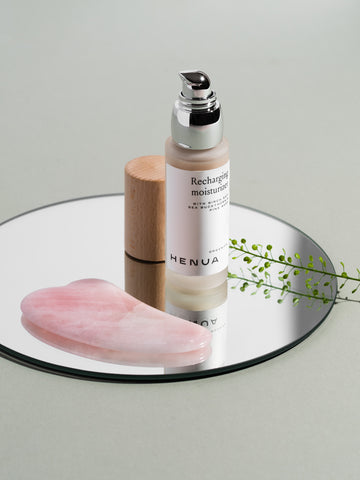Going waterless allows for supercharged formulas
Short Finnish translation at the end of the blog post.
Take a skincare product. Any skincare product. Look at the back. What is at the top of the ingredient list? That’s right, water.
Calling it by its latin name ‘Aqua’ doesn’t change the fact that the most commonly used filler for all skincare is plain old water. And there is lots of it. That is why it is at the very top of the list. Now, while water is a great, clear, light base for formulas - and here in Finland also clean and safe - it doesn’t add anything to the mix. Sure, it helps making the consistency nice, helps other active ingredients blend and so on. But what if you could have all that and have a base that doesn’t water down (pun intended) the efficacy?

Waterless is trending now
The waterless beauty trend originated like so many other beauty phenomenons, from South Korea a few years back. The idea originally was to increase the efficacy of skincare. Quickly the trend has evolved into a global movement and in addition to effectiveness, users are touting the travel and environmental friendly approach that is non-toxic. In its most extreme form, products like shampoo are being compressed into bars, like soap, that don’t require a plastic bottle but can be packed into ecological alternatives, eliminating also plastic waste.
As the trend has swept the planet, waterless has found its way from skincare to hair and makeup too. And while waterless products tend to sit on the pricier side of the spectrum, users are getting more value for their money since you need less of the actual product that is much more potent than the traditional alternative.
Big results in a small package
The word ‘filler’ sounds like a chemical, synthetic ingredient that is added to products to serve a purpose. We are not used to thinking of water as filler. But that is exactly what it is when it comes to beauty. The reason it is used, is that it is a very cheap way to formulate a product.
Quite simply, the use of water, which in a typical skin care product can easily make up for over half of the formula, is diluting the efficacy of the active ingredients. An easy example of a waterless product would be a facial oil. A more complex one is a moisturiser, where the traditional tap water has been replaced with another alternative, like birch sap or some other plant extract.
The difference in results between plain old water-based and replacement with alternative (e.g birch sap or rose water) can be dramatic. Especially people with dry and sensitive skin have reported on their experiences where the change is incredibly quick when they switch to aqua-free.

Should I, or shouldn’t I?
Going waterless is not difficult. In a few short years, waterless formulas are popping up both in luxury aisles as well as supermarkets. Not all waterless is better though. For example, if you are intrigued by the idea because of the environmental aspect, think about how the product is being manufactured. Even if the water in the formula has been replaced by a fruit extract, it might be that the extraction process requires lots of water. So it is always a sum of many factors.
In terms of skincare results, waterless can have benefits beyond just efficacy and potency of active ingredients. They might for example absorb better into skin because of the molecule size of the plant extracts used instead of hard water. Birch sap is a great example of that.
But like with every trend, it always comes down to individual preferences and your skin's reaction to it. For anyone who is interested in scaling down and simplifying their skincare routine, waterless beauty is definitely an option to try. If you are aiming for cleaner products and shorter ingredient lists, then why not start at the very top.
In this case maybe more than ever, less is more.

Lyhyesti suomeksi
Ihonhoitotuotteiden yleisin ainesosa on vesi. Tavallinen, tuttu ja turvallinen mutta myös mitäänsanomaton ja turha kun puhutaan tehokkaista ihonhoidon ainesosista. Vesi tekee tuotteiden koostumuksesta miellyttävän levittää, mutta mitä jos voisit saada miellyttävän tunteen ja tehon samalla kertaa?
Vedettömät tuotteet saivat alkunsa Koreassa, ja niiden tavoite oli yksinkertaisesti tehdä kosmetiikasta tehokkaampaa. Samalla kuitenkin syntyi ekologisia, vähemmän pakkausmateriaalia tarvitsevia tuotteita, kun koostumukset pienenivät veden jäätyä pois kokonaisuudesta.
Vettä käytetään tuotteissa fillerinä, eli sen tehtävä on sekoittaa muut ainesosat tasaisesti. Kuitenkin se samalla laimentaa tuotteen kokonaistehoa. Jättämällä veden pois tai korvaamalla sen esimerkiksi koivunmahlalla, saadaan sama vaikutus mutta myös filleri on tässä tapauksessa tehokas ja auttaa tuotteen aktiiviaineita imeytymään ihoon.
